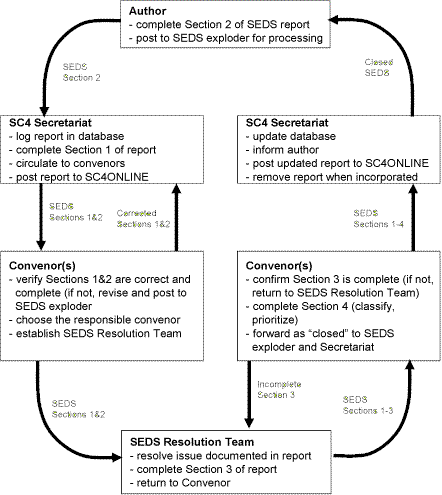
| Help TOC > Raising SEDS | |
| Raising SEDS |
This chapter describes what (a) "SEDS" is, when it is used, and how to use it. The content is a copy of the "SC4 Organization Handbook, Clause 3 - Maintenance" documentation.
To provide an orderly process for submitting and resolving problems encountered in developing, implementing and the use of the SC4 standards and standing documents, and to gather requirements and proposals for enhancements to future editions, the Standard Enhancement and Discrepancy System (SEDS) tracking system has been implemented by the SC4 secretariat.

Reports of problems or errors in the SC4 International Standards or standing documents shall be submitted using the form described below.
Section 1. GENERAL INFORMATION (completed by SC4 Secretariat/WG Convener): SEDS Report Number: Date Submitted: Status: Assigned WG: SEDS Team Leader: SEDS Team Members: Section 2. ENHANCEMENT AND DISCREPANCY INFORMATION (completed by Author of SEDS Report): Author: Email Address: Part and Clause where Issue Originates: Other Parts Affected by the Issue: Related Issues: Summary/Abstract/Keywords: Problem Description: Conditions Under Which the Issue Was Discovered: Proposed Solution (Optional): Section 3. RESPONSE INFORMATION (completed by SEDS Resolution Team Leader): If Accepted, Resolution: Section 4. FOLLOW-UP INFORMATION (completed by WG Convener): Class: Priority: Impact of Change: Further Action Required: Action Required by SEDS Coordinator/WG Conveners/QC/SC4:
This same form shall be used to submit suggestions and requests for enhancements or corrections to SC4 International Standards and standing documents. It is expected that users, implementors and standards developers will be among the population of those submitting reports. There are no requirements or qualifications that are placed on the submitter of the report beyond completing the information required on the SEDS form. SC4 does not want to inhibit the submission of reports. A submitter, however, should expect to be available for:
Any issues submitted during the ISO ballot process that are classified as "deferred" during the ballot resolution process are transferred into the SEDS process by the responsible project leader and/or convener. This procedure ensures that all relevant issues are considered when amendments or new editions are being proposed or developed. All issues transferred from ballots are assigned priority 0 or priority 1, as defined in the chapter Priority below.
SEDS reports shall be submitted in electronic form to the SC4 secretariat. The SC4 secretariat shall:
The responsible convener shall:
The SC4 secretariat shall:
The classification system for SEDS reports has been established to categorize the needed resolution of the issues raised by the report. In addition a system of priorities is established to convey the urgency for incorporating the reports in an International Standard or standing document.
Each SEDS report shall be assigned to one of the classes below. The submitter may provide a classification, but the responsible convener ultimately determines the classification.
Class T (technical corrigendum)
The report identifies a fault that will result in unsafe or incorrect application of the standard. A correction shall be immediately developed and technical corrigendum shall be prepared.
The report identifies an omission, ambiguity, unclear text or an inadequate definition.
Clarifying information shall be developed and provided in the completed report. This information should be useful to those attempting to use the standard and encountering a similar difficulty, but need not take the form of a proposed revision to the standard.
A comprehensive response shall be developed when an amendment or revision to the standard or standing document is prepared. During this preparation, the resolution of the report might be combined with other SEDS reports.
The report identifies a new requirement. Discussion of possible means of satisfying the requirement shall be initiated, but a final specification need not be developed. The provision of specifications to meet the requirement shall be provided in the next amendment or revision, when it may be combined with other SEDS reports.
The report identifies a minor editorial change having no consequence in the application of the International Standard or standing document. A change shall be made in the next amendment or revision.
For each SEDS report, a priority shall be assigned to indicate the urgency of issuing a technical corrigendum or incorporating the results of the report resolution into an International Standard or revised Standing Document. The values to be assigned are:
The SC4 secretariat tracks the incorporation of SEDS issues on a per-part basis. Often a single SEDS report will affect several parts. When a SEDS report is closed and incorporated into a technical corrigendum, amendment or revision, the cover for that document shall enumerate the SEDS reports incorporated by that document.